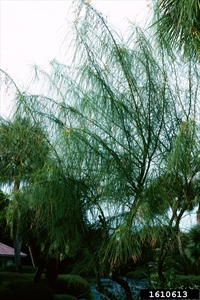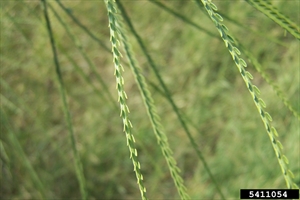Jerusalem thorn; It is also known as Barbados flower-fence, horse bean, jelly bean tree, or parkinsonia.
Pacific Pests, Pathogens, Weeds & Pesticides - Online edition
Pacific Pests, Pathogens, Weeds & Pesticides
Jerusalem thorn (442)
Parkinsonia aculeata. It was known previously as Mimosa bimocronata. It is a member of the Fabaceae.
Africa, Asia, North, South and Central America, the Caribbean, Europe, Oceania. It is recorded from Australia, Federated States of Micronesia, Guam, and New Caledonia.
It is native to southern North America, northern Mexico, the Galapagos Islands and northern South America.
An important weed in some Pacific island countries. Invasive in hot regions (sub-humid and arid), and has become naturalised and weedy everywhere, whether native or introduced. Jerusalem thorn is mostly found growing near creeks, rivers, bores and dams in semi-arid regions (especially those with a distinctive wet and dry season). It also colonises grasslands, open woodlands, rangelands, pastures, waste areas, disturbed sites and roadsides. It can grow up to1500 masl. Its invasive weediness is related to the production of large amounts of seeds and ability to tolerate a wide range of soils, including those seasonally flooded.
Jerusalem thorn is an upright spiny shrub or small tree often forming dense thickets. It can grow to 8 m, but more commonly is between 2-6 m (Photo 1). It can be single or multi-stemmed. The smooth, green stems are slender and tend to droop and zig-zag (Photo 2). Young stems have a pair of spines, 3-20 mm long, below each leaf. Leaves with flat, green, leaf stalk, up to 30 cm long and 2–3 mm wide, with numerous small, 4–10 mm, green, oblong leaflets staggered along both sides (Photos 3&4).
Flowers about 20 mm across with four yellow petals and one erect orange or orange-spotted petal (Photos 5&6). Seed pods, 30–130 mm long, straight with bulges around seeds and points on both ends; they are straw-brown when ripe. Generally, pods contain 1-4 seeds, but occasionally up to 11. Seeds are olive-green to brown and oblong, 10 mm by 4 mm. The roots are mostly shallow.
Jerusalem thorn reproduces mainly by seed, but can also produce suckers (particularly after it has been damaged). The seeds are spread by birds and other animals, especially cattle, and seed pods float in water and can be carried from upper catchment areas downstream. Also carried long distances in mud on animals and vehicles. One tree can produce more than 5000 seeds per year.
A serious pest in many countries. It is one of Australia's worse weeds, and is a problem in tropical Africa, Hawaii and other Pacific island countries. Impacts are both environmental and economic. Effects upon livestock grazing are considerable in Australia due to competition with forage grasses, blocking access to water sources, damage to hooves and the consequences from infected sores. Thickets of the tree are also home to feral animals, pigs in particular. Detailed economic assessments are lacking.
Often introduced as a fodder tree, for hedging, shade, wind-breaks or as an ornamental able to tolerate dry and saline sites and waterlogging. Seeds are rich in protein and are eaten. Medicinal properties are reported.
BIOSECURITY
There is a high risk of introduction. Countries not yet infested by Jerusalem thorn should consider all likely pathways for entry, and apply quarantine measures accordingly. In many countries, Parkinsonia aculeata is a restricted invasive plant under biosecurity acts in some parts of Australia; this means - a person must not release these invasive plants into the environment, give away or sell as a plant or something infested with its seeds.
If prevention is no longer possible, treat the infestations as soon as possible, and especially when they are small, and before they seed. The methods chosen will depend on terrain, cost, availability of labour, and the severity of the infestation.
BIOCONTROL
Four insects have been introduced to Australia, two seed beetles (Penthobruchus germaini and Mimosestes ulkei) which attack the mature seeds, one leaf bug (Rhinacloa callicrates) which feeds on the leaves and shoots, and a leaf-feeding looper (Eueupithecia cisplatensis). Unfortunately, in Australia, Penthobruchus eggs are being attacked by a native wasp and this beetle is no longer useful as a biological control agent.
CULTURAL CONTROL
Note, water is responsible for much of the spread of Parkinsonia, making the control of outbreaks on watercourses a priority, particularly those in upper catchment areas. These outbreaks have the potential to infect new areas or those where control has been established.
- Physical & Mechanical:
-
Any machinery used in infested areas should be thoroughly cleaned before moving to areas uninfested by the weed.
-
Hand-weed seedlings, and dig out small trees, but be careful of the thorns!
-
Use a large heavy chain dragged across the ground by heavy machinery to pull out mature trees. But note, many smaller plants are just bent over, and they straighten up once the chain has passed. It is not a method suited to uneven ground or along riverbanks as it can cause erosion and damage non-target species.
-
Bulldozing, and deep ploughing can be effective, but must be followed up as it brings seeds to the surface.
-
-
Movement of sand and soil:
-
Do not move soil or sand from infested areas which could contain Senegalia seeds.
-
- Fire:
-
Fire can control seeds and seedlings though adult plants are not very susceptible. It is inexpensive, but requires good management to prevent loss of stock and property; there is also potential for erosion when heavy rain follows soon after burning.
-
CHEMICAL CONTROL
Herbicides should be applied ideally when the trees are actively growing, generally in the hot, wet season.
- Foliar applications provide effective control from the time that plants are seedlings to 2 m tall. A wetting agent should be used. It is not recommended near waterways.
- Near waterways, use the cut-basal-bark (or ring bark) treatments: (i) make a 2-3 cm deep cut into the bark right around the trunk at about 75 cm from ground level, and apply herbicide to the wood inside the bark; or (ii) for small trees, cut them down at ground level and then apply herbicide to the cut.
- Away from waterway, larger trees can also be treated with a liquid or granular herbicide. If liquid, wet the bark with the herbicide from about 1 m above the ground, letting the liquid pool at the base of the tree.
For best results with herbicides, the soil should be moist, and plants should be actively growing.
In Australia, the following are registered: triclopyr + picloram; triclopyr + picloram + aminopyralid; hexazinone; tebuthiuron. Triclopyr + picloram is used with diesel (as stump application). In Fiji, glyphosate.
--------------------
Note, in the EU, approval to use glyphosate ends in December 2022; its use after that date is under discussion.
____________________
When using a pesticide, always wear protective clothing and follow the instructions on the product label, such as dosage, timing of application, and pre-harvest interval. Recommendations will vary with the crop and system of cultivation. Expert advice on the most appropriate herbicides to use should always be sought from local agricultural authorities.
AUTHORS Grahame Jackson & Aradhana Deesh
Adapted from Parkinsonia (Parkinsonia aculeata) (2018) Weeds of SE Qld and Northern NSW. Lucidcentral. (https://www.lucidcentral.org/editors-pick-animal-and-plant-identification-keys/key-to-weeds-of-se-qld-and-northern-nsw); and additional information from Parkinsonia aculata. Wikipedia. (https://en.wikipedia.org/wiki/Parkinsonia_aculeata); and CHAH (2020) Parkinsonia aculeata L. Parkinsonia. WeedsAustralia - Profiles. Department of Sustainability, Environment, Water, Population and Communitie. (https://profiles.ala.org.au/opus/weeds-australia/profile/Parkinsonia%20aculeata); and Parkinsonia: declared pest (2019) Department of Primary Industries and Regional Development. Government of Western Australia. (https://www.agric.wa.gov.au/declared-plants/parkinsonia-declared-pest); and from DAF (2020) Parkinsonia Jerusalem thorn or jelly bean tree Parkinsonia aculeata. Queensland Government. (https://www.daf.qld.gov.au/__data/assets/pdf_file/0014/55040/parkinsonia.pdf). Photo 1 Hectonichus Parkinsonia aculeata - Athens, Greece; Photo 2 John Ruter, University of Georgia, Bugwood.org; Photos 3&4 Karen A. Rawlins, University of Georgia, Bugwood.org; Photos 5&6 William M. Ciesla, Forest Health Management International, Bugwood. org.
Produced with support from the Australian Centre for International Agricultural Research under project HORT/2016/185: Responding to emerging pest and disease threats to horticulture in the Pacific islands, implemented by the University of Queensland, in association with the Pacific Community and Koronivia Research Station, Ministry of Agriculture, Fiji.









